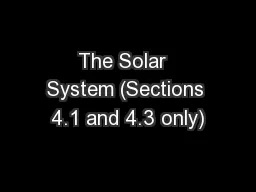

Ingredients Planets Their Moons Rings Comets Asteroids Meteoroids Kuiper Belt Objects The Sun A lot of nearly empty space Solar System Perspective Orbits of Planets All orbit in same ID: 778618
Download The PPT/PDF document "The Solar System (Sections 4.1 and 4.3 ..." is the property of its rightful owner. Permission is granted to download and print the materials on this web site for personal, non-commercial use only, and to display it on your personal computer provided you do not modify the materials and that you retain all copyright notices contained in the materials. By downloading content from our website, you accept the terms of this agreement.
Slide1
The Solar System (Sections 4.1 and 4.3 only)
Ingredients?
Planets
Their Moons, Rings
Comets
Asteroids
Meteoroids
Kuiper Belt Objects
The Sun
A lot of nearly empty space
Slide2Solar System Perspective
Slide3Orbits of Planets
All orbit in same direction.
Most orbit in same
plane.
Elliptical
orbits, but low eccentricity for most, so
nearly circular.
Slide4Exceptions:
Mercury
Pluto
(no longer a planet)
orbital tilt 7
o
orbital tilt 17.2
o
eccentricity 0.21 eccentricity 0.25
Slide5Sun, Planets and Moon to scale
(Jupiter’s faint rings not shown)
Slide6Two Kinds of Planets
"Terrestrial"
Mercury, Venus,
Earth, Mars
"Jovian"
Jupiter, Saturn, Uranus, Neptune
Close to the Sun
Small
Far from the Sun
Large
Few Moons
No Rings
Main Elements Fe, Si,
Mg, O
Mostly Rocky
High Density (3.9 -
5.5
g/cm
3
)
Slow Rotation (1 - 243 days)
Mostly
Gaseous, Liquid
Low Density (0.7 -1.6 g/cm
3)
Many MoonsRingsMain Elements H, He
Fast Rotation (0.41 - 0.72 days)
Slide7How did the Solar System Form?
We weren't there. We need a good theory. Check predictions
against other forming solar systems. What must it explain?
- Solar system is very flat.
- Almost all moons and planets orbit and spin in the same direction
. Orbits nearly circular.
- Planets are isolated in space.
- Terrestrial - Jovian planet distinction.
- Leftover junk (
comets, asteroids,
etc
).
Not the details and oddities – such as Venus’ and Uranus’ retrograde spin.
Slide8Early Ideas
René Descartes (1596 -1650)
nebular theory
:
Solar system formed out of a "whirlpool" in a "universal fluid". Planets formed out of eddies in the fluid.
Sun formed at center.
Planets in cooler regions.
Cloud called "Solar Nebula".
This is pre-Newton and modern science. But basic idea correct, and the theory evolved as science
advanced . . .
Slide9A cloud of interstellar gas
The associated dust blocks starlight. Composition mostly H, He.
a few light-years,
or about 1000
times bigger than
Solar System
Too cold for optical emission but some radio spectral lines from molecules. Doppler shifts
indicate
clouds rotate at a few km/s.
Some clumps within clouds collapse under their own weight to form stars or
star clusters.
Clumps spin at about 1 km/s.
Slide10But why is Solar System flat, and why do planets orbit faster than 1 km/s?
Pierre Laplace (1749 - 1827): an important factor is "conservation of angular momentum"
:
When a rotating object contracts, it speeds up.
"momentum"
"angular momentum" (a property of a spinning or orbiting object)
mass x velocity
mass x velocity x "size"
of spin or orbit
of spinning object or orbit
Well demonstrated by ice skaters . . .
Slide11Slide12Slide13So, as nebula contracted it rotated faster.
Could not remain spherical! Faster rotation
tends
to fling matter outwards, so it
collapsed faster
along rotation axis => it became a flattened disk, like a pizza crust.
Hubble is seeing these now!
Slide14Now to make the planets . . .
Solar Nebula: 98% of mass was gas (H, He)
2% in
dust grains
(Fe, C, Si . . .)
Condensation theory
:
1) Dust grains act as "condensation nuclei": gas atoms stick to them => growth of first clumps of matter.
2)
Accretion
: Clumps collide and stick => larger clumps. Eventually, small-moon sized objects: "planetesimals".
3)
Gravity-enhanced accretion
: objects now have significant gravity. Mutual attraction accelerates accretion. Bigger objects grow faster => a few planet-sized objects.
About 0.1 microns
Slide15initial gas and dust nebula
dust grains grow by accreting gas, colliding and sticking
continued growth of clumps of matter, producing
planetesimals
planetesimals
collide and stick, enhanced by their gravity
result: a few large planets. Much
l
eftover debris
Hubble observation of disk around young star with ring structure. Unseen planet sweeping out gap?
Slide16Terrestrial - Jovian Distinction
Jovian solid cores ~
10-15
M
Earth
. Strong gravity => swept up and retained large gas
envelopes of mostly H, He.Outer parts of disk cooler: ices form (but still much gas), also ice "mantles" on dust grains => much solid
material for accretion => larger planetesimals => more gravity => even more growth.
Inner parts hotter (due to forming Sun):
no ice.
Accretion of gas atoms onto dust grains relatively inefficient.
Composition of Terrestrial planets reflects that of initial dust –
not representative of Solar
System, Milky
Way, or Universe.
Slide17Asteroid Belt
Perhaps a planet was going to form there. But Jupiter's strong gravity disrupted
planetesimals
' orbits, ejecting them out of Solar System. The Belt is the few left behind.
And Finally . . .
Leftover planet building blocks are the asteroids, meteoroids, Kuiper Belt Objects and comet “nuclei”. But most swept up by Jupiter, fell into Sun, or ejected from Solar System.
Remaining gas swept out by Solar Wind.
Slide18Slide19Result from computer simulation of planet growth
Shows growth of terrestrial planets. If Jupiter's gravity not included, fifth terrestrial planet forms in Asteroid Belt. If
Jupiter
included, orbits of
planetesimals
there are disrupted. Almost all ejected from Solar System.
Simulations also
suggest
a few Mars-size objects formed in Asteroid Belt. Their gravity modified orbits of other
planetesimals
, before they too were ejected by Jupiter's gravity.
Asteroid Ida